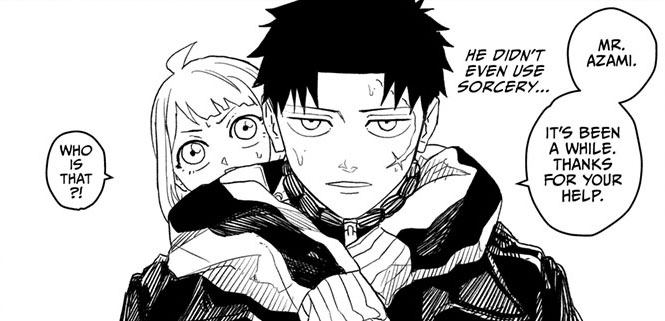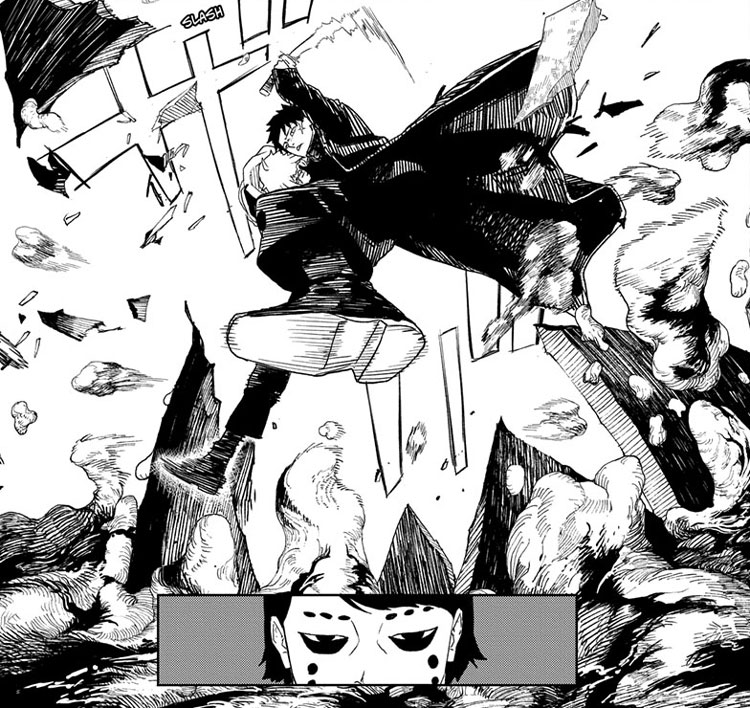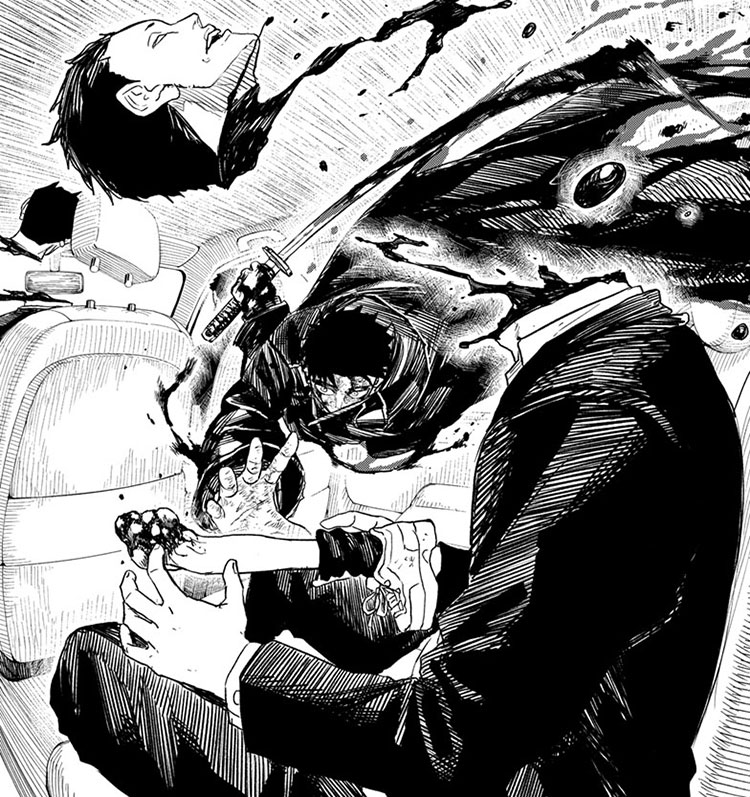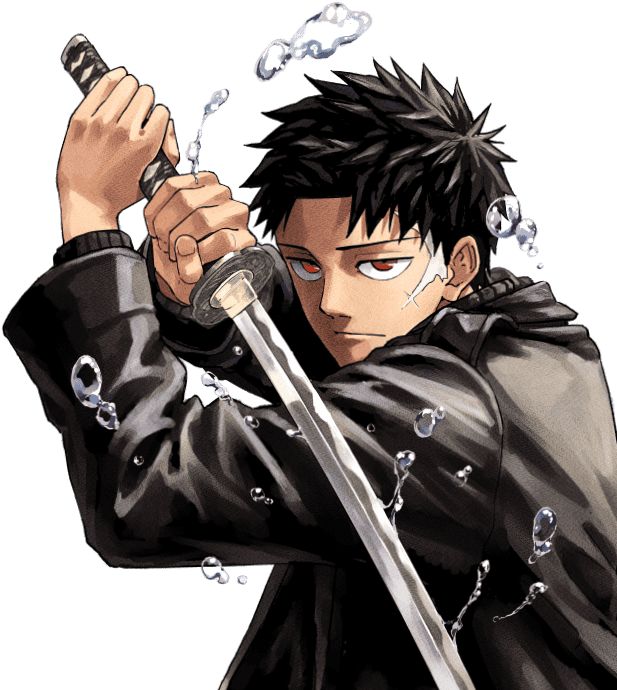The birth of Kagurabachi !
── Please tell us how Kagurabachi came to be.
Imamura: It was because Hokazono said that he wanted to “make a revenge story.” Back then, I thought that doing a revenge story in a shonen magazine was relatively uncommon. However, considering that Hokazono had been drawing revenge stories as one-shots, I decided to take on the challenge, believing that it would lead to the creation of an interesting piece of work.
── Is there a reason Hokazono-sensei wanted to create a “revenge” story?
Imamura: I think it’s simply his favorite genre. Hokazono likes Western movies, especially Tarantino films. Lately, he seems to be a fan of movies like “John Wick” as well. I believe he wanted to draw the kind of revenge story often featured in those types of films. Rather than trying to draw a “Jump-like” story, he’s adopting a stance of drawing what he personally likes.
── How did the realistic Japanese world with a touch of the past come about? Were international readers in mind during creation?
Imamura: I believe the inspiration for this also came from Western films. Hokazono enjoys not only films but also the game “Ghost of Tsushima,” which features many distinctly Japanese motifs. Perhaps he finds the concept of the “overseas imagery of Japan” or a “cool-looking Japan” interesting. So, he intentionally incorporates quintessentially Japanese items like “swords” and “goldfish” at key points. However, since he’s creating it with the intention of gaining popularity in the Jump magazine, we hadn’t consciously considered how it might appeal internationally. When I heard it was buzzing overseas after the serialization started, I was surprised, thinking, “Wait, it’s popular there?” It was a pleasantly unexpected response, like a happy miscalculation.

When Chihiro wields his sword, a goldfish appears?! Keep an eye out for the other sword motifs.
── How was Chihiro created?
Imamura: Chihiro was the character Hokazono created when he said, “Isn’t a character in all black really cool?” In Japan, the Jump magazine is sold in print, so there was the concern about the color bleeding and scenes turning completely black. However, I think it turned out well. It’s often well-utilized in scenes where he smoothly emerges from the darkness.
── Can you share how the female character Char came to be?
Imamura: Having only Chihiro driving the narrative with a vengeance plot would make the overall story too dark. So, there was a need for a character who could lighten the mood. Initially, we had a vague idead of “We probably need one more party member,” without a clear image of a small and cute girl like the current one. That’s when Hokazono created a girl named Char.

Char has been a memorable character from her first appearance. Her backstory is also noteworthy.
── How do you come up with the developments and direction of the story?
Imamura: I had envisioned a typical shonen manga-like development where the protagonist, Chihiro, becomes physically stronger through his mental growth. To achieve that, Sojo, the formidable enemy was introduced quite early in the story. He serves as the “first powerful enemy” that spices up the narrative, a common element in shonen manga. Chihiro has the goal of avenging his fater by killing Hishaku, who killed his father, and it turns out that Hishaku is the ultimate boss of the story. A battle with Sojo was set up in the early stages to progress toward that point.
The process of creating the story!
── Can you tell us how you conduct each meeting and what you often discuss at meetings?
Imamura: I have in-person meetings with Hokazono once or twice a week. After he’s finished one chapter, we discuss the next chapter and so on in sequence. The overall framework of the story has been roughly defined, so the process now involves fleshing out the details of each chapter based on that. Of course, during disscussions, the story can take unexpected turns and deviate from the initially planned direction. For instance Sojo was initially created as one half of a duo. However, through discussing the best approach, we settled on the current character.
── Are the meetings solely about the story?
Imamura: It’s not all serious talk. We do talk about unrelated stuff as well. Naturally, there's a lot of talk about “Jump.” We often discuss how interesting other works are.
── The two page spreads and panel work are very distinctive. Do you give sensei any advice regarding these aspects?
Imamura: It’s completely Hokazono’s work, and I rarely give feedback about significant changes. I’ll sometimes tell him stuff like “Enlarging Chihiro’s face would make it easier to convey his emotions better.”
── Can you tell us a highlight of Kagurabachi?
Imamura: No doubt the action.

Slashing through the roof of the ambushed car, Chihiro makes a daring leap, marking a vivid start to the battle!
About Hokazono-sensei!
── From your point of view, what type of person is Hokazono-sensei?
Imamura: He submitted to the Tezuka Award at the age of 19, won an award and within about two years started a serialization. He possess remarkable talent. Perhaps due to his youth, there’s an impression of a very straightforward approach to drawing. Apparently he began drawing manga during the COVID-19 pandemic when we all had to stay at home. He’s also a very kind person. What suprised me was that he hadn’t been to a hair salon in about 10 years. He’s been cutting his own hair, but from what I’ve seen, it always looks very neat and styled. He might have a talent not just in manga but also in hairstyling.
── Is there a manga work that Hokazono-sensei has been influenced by?
Imamura: He just absolutely loves “Naruto.” If you take a look at his Tezuka award-winning piece and early one-shots, the influence is quite evident. He's also explored other highly popular series like “Chainsaw man,” “Attack on Titan,” and “Ajin: Demi-Human.”
── With that background, wanting to tackle a "revenge story" in "Jump" must be quite challenging.
Imamura: Hokazono grew up reading “Jump,” so naturally, there was a desire to serialize in “Jump.” Moreover, his aspiration to become a manga artist stems from “Naruto,” adding to its significance.
── Though this is Hokazono-sensei’s first series, can you share any insights into the growth and changes you’ve noticed?
Imamura: I feel his art has improved. For the one-shot, his lines still had a novice touch, but it’s rapidly matured with the start of Kagurabachi. I believe he has been putting a lot of effort into his drawings even amidst his busy weekly serialization. Another change is that he’s started to take walks (laughs). Apparently he makes more progress thinking while walking around the neighborhood rather than sitting at his desk.
There’s more to come for Kagurabachi !
── As editor, do you have any favorite characters or scenes?
Imamura: My favorite character has to be the main character, Chihiro. He’s so cool. My favorite scene is chapter 10 when Chihiro jumps into the car to save Char. The action is stunning, and I was mezmerized by it.

A great action scene in which he slashes enemies while jumping into a car! A magnificent framing unique to Hokazono-sensei.
──Can you tell us the future plans and goals for Kagurabachi?
Imamura: I hope it’ll become an even more popular manga. Thankfully, the international popularity is extremely high, so I’d like to keep up the popularity in Japan as well. Eventually, our goal is to make it into an anime!
──Lastly, do you have a message for the readers of MANGA Plus?
Imamura: Thank you so much for reading Kagurabachi. To be honest, Hokazono and I had never imagined that Kagurabachi would become so popular internationally, so we’re really grateful for the reception it’s gotten. We hope you’ll continue to enjoy Kagurabachi.

Q1 Can you tell us your initial goals for Kagurabachi, if any?
Hokazono: I wanted to find a structure and direction that had never been seen before.
Q2 Can you tell us the characters you enjoy drawing and which you find difficult to draw?
Hokazono: I enjoy drawing Sojo. The characters I have a hard time with are the female characters.
Q3 What has been your favorite scene in the series so far?
Hokazono: The sequence of events from when Sojo is in the bathhouse to the confrontation with Kamunabi (chapter 12). The scene where Daruma dies (chapter 8) is also a favorite.
Q4 Do you have any references or special routines that you use when writing?
Hokazono: I watch a lot of movies. When I get stuck, I take a shower. So, when working on challenging chapters, my water bill tends to rise.
Q5 What are you most interested in now?
Hokazono: I want to see a movie at the cinema!!







